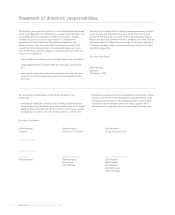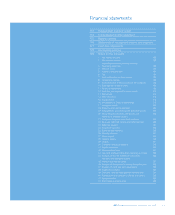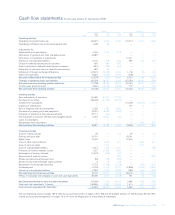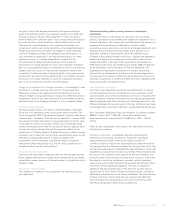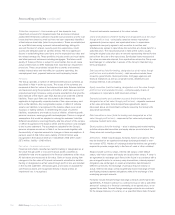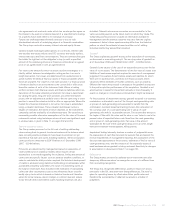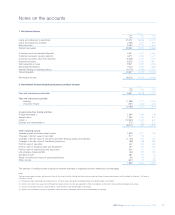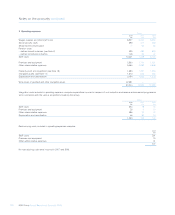RBS 2008 Annual Report Download - page 181
Download and view the complete annual report
Please find page 181 of the 2008 RBS annual report below. You can navigate through the pages in the report by either clicking on the pages listed below, or by using the keyword search tool below to find specific information within the annual report.
Accounting policies continued
RBS Group Annual Report and Accounts 2008180
Acquired goodwill, being the excess of the cost of an acquisition over
the Group’s interest in the net fair value of the identifiable assets,
liabilities and contingent liabilities of the subsidiary, associate or joint
venture acquired, is initially recognised at cost and subsequently at cost
less any accumulated impairment losses. Goodwill arising on the
acquisition of subsidiaries and joint ventures is included in the balance
sheet category ‘Intangible assets’ and that on associates within their
carrying amounts. The gain or loss on the disposal of a subsidiary,
associate or joint venture includes the carrying value of any related
goodwill.
On implementation of IFRS, the Group did not restate business
combinations that occurred before January 2004. Under previous GAAP,
goodwill arising on acquisitions after 1 October 1998 was capitalised
and amortised over its estimated useful economic life. Goodwill arising
on acquisitions before 1 October 1998 was deducted from equity. The
carrying amount of goodwill in the Group’s opening IFRS balance sheet
(1 January 2004) was £13,131 million, its carrying value under previous
GAAP.
7. Property, plant and equipment
Items of property, plant and equipment are stated at cost less
accumulated depreciation and impairment losses. Where an item of
property, plant and equipment comprises major components having
different useful lives, they are accounted for separately. Property that is
being constructed or developed for future use as investment property is
classified as property, plant and equipment and stated at cost until
construction or development is complete, at which time it is reclassified
as investment property.
Depreciation is charged to profit or loss on a straight-line basis so as to
write-off the depreciable amount of property, plant and equipment
(including assets owned and let on operating leases (except investment
property – see accounting policy 9)) over their estimated useful lives.
The depreciable amount is the cost of an asset less its residual value.
Land is not depreciated. Estimated useful lives are as follows:
Freehold and long leasehold buildings 50 years
Short leaseholds unexpired period
of the lease
Property adaptation costs 10 to 15 years
Computer equipment up to 5 years
Other equipment 4 to 15 years
Under previous GAAP, the Group’s freehold and long leasehold property
occupied for its own use was recorded at valuation on the basis of
existing use value. The Group elected to use this valuation as at 31
December 2003 (£2,391 million) as deemed cost for its opening IFRS
balance sheet (1 January 2004).
8. Impairment of intangible assets and property, plant and equipment
At each reporting date, the Group assesses whether there is any
indication that its intangible assets, or property, plant and equipment
are impaired. If any such indication exists, the Group estimates the
recoverable amount of the asset and the impairment loss if any.
Goodwill is tested for impairment annually or more frequently if events
or changes in circumstances indicate that it might be impaired. If an
asset does not generate cash flows that are independent from those of
other assets or groups of assets, recoverable amount is determined for
the cash-generating unit to which the asset belongs. The recoverable
amount of an asset is the higher of its fair value less cost to sell and its
value in use. Value in use is the present value of future cash flows from
the asset or cash-generating unit discounted at a rate that reflects
market interest rates adjusted for risks specific to the asset or cash-
generating unit that have not been reflected in the estimation of future
cash flows. If the recoverable amount of an intangible or tangible asset
is less than its carrying value, an impairment loss is recognised
immediately in profit or loss and the carrying value of the asset reduced
by the amount of the loss. A reversal of an impairment loss on
intangible assets (excluding goodwill) or property, plant and equipment
is recognised as it arises provided the increased carrying value does
not exceed that which it would have been had no impairment loss been
recognised. Impairment losses on goodwill are not reversed.
9. Investment property
Investment property comprises freehold and leasehold properties that
are held to earn rentals or for capital appreciation or both. It is not
depreciated but is stated at fair value based on valuations by
independent registered valuers. Fair value is based on current prices for
similar properties in the same location and condition. Any gain or loss
arising from a change in fair value is recognised in profit or loss. Rental
income from investment property is recognised on a straight-line basis
over the term of the lease. Lease incentives granted are recognised as
an integral part of the total rental income.
10. Foreign currencies
The Group’s consolidated financial statements are presented in sterling
which is the functional currency of the company.
Transactions in foreign currencies are translated into sterling at the
foreign exchange rate ruling at the date of the transaction. Monetary
assets and liabilities denominated in foreign currencies are translated
into sterling at the rates of exchange ruling at the balance sheet date.
Foreign exchange differences arising on translation are reported in
income from trading activities except for differences arising on cash
flow hedges and hedges of net investments in foreign operations. Non-
monetary items denominated in foreign currencies that are stated at fair
value are translated into sterling at foreign exchange rates ruling at the
dates the values were determined. Translation differences arising on
non-monetary items measured at fair value are recognised in profit or
loss except for differences arising on available-for-sale non-monetary
financial assets, for example equity shares, which are included in the
available-for-sale reserve in equity unless the asset is the hedged item
in a fair value hedge.
The assets and liabilities of foreign operations, including goodwill and
fair value adjustments arising on acquisition, are translated into sterling
at foreign exchange rates ruling at the balance sheet date. The
revenues and expenses of foreign operations are translated into sterling
at average exchange rates unless these do not approximate to the
foreign exchange rates ruling at the dates of the transactions. Foreign
exchange differences arising on the translation of a foreign operation
are recognised directly in equity and included in profit or loss on its
disposal.


